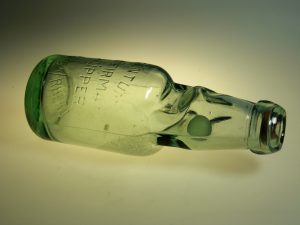Bottles: Clicker bottle - German/German

"The brats always stole our bottles and broke them, you had to be careful ...", a beverage bottler once complained. The "brats" had it in for the glass marbles in the Knicker or clicker bottles. According to a contemporary witness, the exchange rate was 50 clay marbles. Knicker or clicker bottles were widespread during the "Büdchen" or drinking hall culture from 1880 to the 1950s, especially in the cities of the Ruhr area.
With the help of a glass marble, it was possible to seal bottles airtight. This was particularly important due to the emergence of carbonated mineral waters. The gas escaped from the still common earthenware bottles and the corks flew out of the simple glass bottles. The glass marble, on the other hand, was pressed under a rubber ring by the internal gas pressure of the carbonic acid and thus sealed the bottle airtight.
To open the bottle, the marble had to be pushed back into the bottle with a finger or wooden stick. There it found a hold in the "constricted" neck of the bottle. The contents could be poured out without the marble closing the neck opening.
Bottles: Codd-Neck Bottle - English

"The urchins always stole our bottles and smashed them to pieces, you had to watch out ...", complained a drink filler once. The urchins were keen on the glass marbles in the codd-neck bottles. According to a contemporary witness the exchange rate was 1 to 50 clay marbles. The German equivalent of Codd-Neck Bottles became popular during the period of the kiosk or refreshment stand culture from 1880 until into the 1950s in above all, towns in the Ruhr region.
The glass marble made it possible to create an airtight seal in the bottles, which was extremely important in the face of the emerging trend for carbonated mineral water. The gas leaked out of the usual stoneware bottles and the cork flew out of simple glass bottles. The pressure of the gas in the carbonated liquid on the other hand pressed the marble against a rubber ring, which closed the bottle and made it airtight.
To open the bottle, the marble had to be pushed back into it with a finger or piece of wood, where it caught in the constricted bottleneck. The contents could then be poured out without the marble closing the opening.